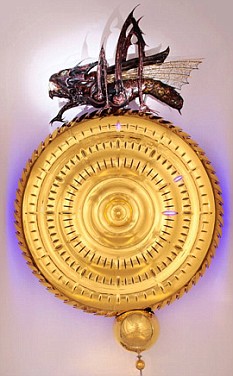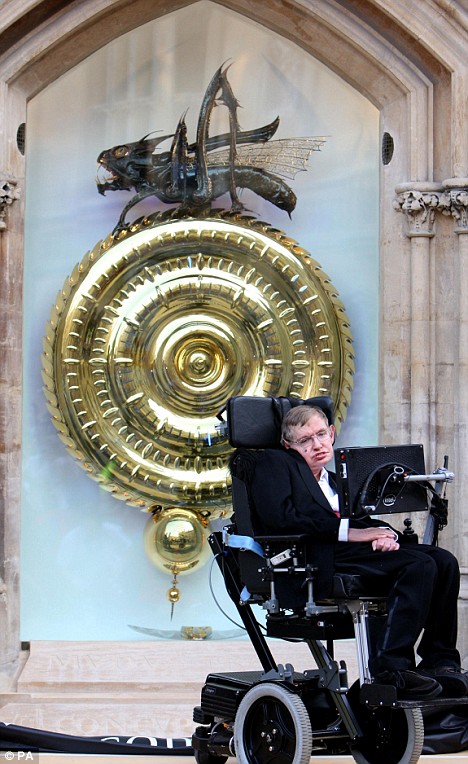 I love this stuff. It seems as though most all inventors at one point in their life just have to create some method of displaying the time. They can’t call them ‘clocks’ either, that would be too…routine. Here we have a fascinating clock that was donated to Cambridge University in England by successful inventor John C. Taylor, who himself attended Cambridge in the 1950s. He refers to it as a “Chronophage” (something that ‘eats’ time), and named it the “Corpus Clock.” This is likely do to the fact that it will be placed at the Corpus Christi College at Cambridge.
I love this stuff. It seems as though most all inventors at one point in their life just have to create some method of displaying the time. They can’t call them ‘clocks’ either, that would be too…routine. Here we have a fascinating clock that was donated to Cambridge University in England by successful inventor John C. Taylor, who himself attended Cambridge in the 1950s. He refers to it as a “Chronophage” (something that ‘eats’ time), and named it the “Corpus Clock.” This is likely do to the fact that it will be placed at the Corpus Christi College at Cambridge.
Taylor has had a privileged life no doubt aided by his inherent talent and skills. He gained his fortune improving of all things, thermostats. You can read more about him here. About seven years ago he began the development of this clock which he half paid for himself at a total cost of about one million English Pounds. Although this amount seems high, you have to take into consideration the budgets involved when Swiss watch makers create equally unique one-off pieces. Thus, the Corpus Clock was a bit of a bargain! Also, while Taylor is British, not Swiss, it is worth knowing that England has played an impressive role in the watch industry over the years. English watch makers are on the rise after years of relative dormancy. As such, Taylor who is himself an horologist, built the clock in honor of John Harrison, who was an English clock maker in the 18th century who solved the problem of longitude, and developed the “grasshopper” clock escapement (which was internal rather than external at the time). For the Corpus Clock, Taylor made the grasshopper escapement into an actually grasshopper, and placed it on the outside of the clock to visualize it eating away time.
The idea behind the Corpus Clock was two-fold. Represent time in an unorthodox manner, while stressing the fact that once time passes, it is literally eaten away never to return. The former concept is clearly demonstrated by the painstakingly detailed grotesque time eating grasshopper that sits atop the clock. The grasshopper is actually the escapement of the clock, which connects the power source to the mechanism that runs the watch. In this case, it directly operates the seconds elapsation of the clock, which in turn controls both the minutes and hours. Take a close look at the grasshopper a notice the moving eyes, mouth and even tongue. Parts of the head look to be sourced from records of paleolithic fish parts, which seems to share a look and monster like visage. Animated in its constant consumption of time, the grasshopper should be a signal to students taking too long to graduate. Or alternatively, perhaps a signal that once you get out of school, time moves so much faster, so enjoy the slow days of studying while you can. Either way it is a bit ominous.
If that wasn’t enough, the Corpus Clock has another morbid trait. In defiance of the hourly bell chimes, that landmark clocks are often known for, the Corpus Clock emits the sound of a chain falling on a coffin, each hour. An interesting message to view and hear before entering the new library that the clock guards.
 Display of the time is also eccentrically communicated, but in a visually appealing way. You don’t have to investigate long to read the time. There are three circular indicators on the 24k gold plated clock face, with 60 faceted lens each. The inner circle is for hours, then minutes, while the outer circle represents the seconds. The outer circle is the most interesting to watch as the seconds make a complete revolution each second before advancing by one second. This is Taylor’s way of pressing the whole “eating up of time” point. Instead of hands being used to tell the time. The Corpus Clock relies on vertical lens that display light from a centralized LED source. The mechanics of the clock allow for light to access the right lens at the right time so the indicators function like hands. Once you look at the clock in operation, it becomes quite obvious how to use it.
Display of the time is also eccentrically communicated, but in a visually appealing way. You don’t have to investigate long to read the time. There are three circular indicators on the 24k gold plated clock face, with 60 faceted lens each. The inner circle is for hours, then minutes, while the outer circle represents the seconds. The outer circle is the most interesting to watch as the seconds make a complete revolution each second before advancing by one second. This is Taylor’s way of pressing the whole “eating up of time” point. Instead of hands being used to tell the time. The Corpus Clock relies on vertical lens that display light from a centralized LED source. The mechanics of the clock allow for light to access the right lens at the right time so the indicators function like hands. Once you look at the clock in operation, it becomes quite obvious how to use it.
At about four feet in diameter, the clock is an impressive new landmark of Corpus Christi College, and Cambridge University as a whole. The combination of the impressive animations, striking features, and partially external mechanical components on the Corpus Clock easily make it one of the world’s most interesting public clocks. John Taylor is obviously proud of the achievement, and so is Stephen Hawking who presented the clock at its unveiling recently. Professor Stephen Hawking of course, is a faculty member at Cambridge and adds a significant legitimacy to anything he presents, including the clock. If you are in Cambridge, I recommend checking this beast out.
[phpbay]john c taylor | stephen hawking, num, “”, “”[/phpbay]